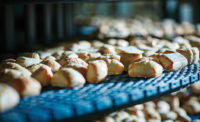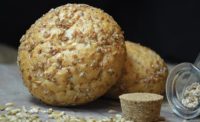Few foods make as seamless of a global translation as the sandwich. And while any type of bread can form the basis of a sandwich, the buns and rolls segment often gets the nod for sandwiches of all stripes. Considering the perennial popularity of sandwiches, it should come as no surprise that buns and rolls all showed growth over the past year.
Overview | Bread | Tortillas | Sweet Goods | Snack Cakes | Pizza | Desserts | Cookies | Buns & Rolls | Bars
Market data
While the overall fresh bread and rolls category was down slightly for the 52 weeks ending April 19, 2015, all buns and rolls segments within the category showed gains. The all other fresh rolls, buns and croissants subcategory was up 2.33 percent in dollar sales, taking in $1.9 billion, per IRI, Chicago. Hamburger and hot dog buns saw a slight rise of 0.90 percent, also responsible for $1.9 billion in dollar sales. And over in the cold case, the minor segment of refrigerated dinner rolls, sandwich rolls and croissants was up 15.65 percent in dollar sales to $690,905.
While private label takes the top sales slot in every bun and rolls segment, most saw losses in dollar sales for the past 52 weeks, with the refrigerated dinner rolls, sandwich rolls and croissants segment as the one exception (although the abnormally large dollar sales gain reported by IRI is likely skewed due to the release of a new product toward the end of the year-ago sales period, making the comparison to the year-ago period unduly weighted in the current period’s favor—we will watch this segment moving forward and expect to see its dollar sales percentage of growth moderate over the coming year).
Looking back
The Bimbo Bakeries USA brand group of Arnold, Brownberry and Oroweat saw significant growth over the 52 weeks ending April 19, 2015, for its Sandwich Thins line, with 105.55 percent dollar sales growth, up to $155.5 million. The Sandwich Thins products available under these brands are now available in multiple varieties: Everything, Flax & Fiber, 100% Whole Wheat, Honey Wheat and Multi-Grain. Front-of-pack messaging for these products includes notations of “100 Calories” per serving and “Excellent Source of Fiber,” among others.
Over the past 52 weeks, King’s Hawaiian also saw gains, up 19.00 percent in dollar sales to $348.6 million, sitting in the No. 2 slot for the all other fresh rolls, buns and croissants segment. The company overall has seen steady growth over the last several years, with associated investment in updating existing bakeries and purchasing new facilities. One new product introduction during the 52-week period was its Mini Sub Rolls.
Both the Sandwich Thins and the King’s Hawaiian Mini Sub Rolls reflect a desired sense of moderation in terms of portion or serving size. Consumers still love the idea of sandwich-centric meals, but seek to incrementally diminish the calorie and carbohydrate impact of the bread they use.
In hamburger and hot dog buns, the EarthGrains Ball Park brand of hamburger and hot dog buns saw a nice gain of 31.89 percent in dollar sales, accounting for $134.2 million in sales.
Overall, traditional hamburger and hot dog buns trended well over the 52-week period, with Wonder buns, a Flowers Foods brand, up 801.93 percent to $23.5 million. King’s Hawaiian hamburger hot dog buns also tracked well, up 16.09 percent to $18.0 million. The bakery reintroduced its hot dog buns during summer 2014.
Looking forward
In addition to nutritional concerns like fiber levels and portion control, bakers of buns and rolls will likely continue to scrub ingredient statements to foster more appeal for label-readers.
“Similar to other categories in the grocery store, the bakery category is working on solutions to offer clean-label products to the consumer,” says Marge O’Brien, senior global market insights manager, Corbion, Lenexa, KS. “While ‘clean label’ is an industry term, it is important to keep in mind that for the consumer, ‘clean’ can mean a variety of things.” She notes that company research has found this notion of “clean” can relate to various ingredient types. “Consumers typically fall into one of three segments: nutrition-focused (46%), ingredient-focused (32%) or less-engaged in labeling information (22%).
“Nutrition-focused consumers place more importance on general health and diet factors, are more likely to look at the first few ingredients on the label and focus more on the nutritional panel,” continues O’Brien. “Ingredient-focused consumers will place more importance on specific ingredients and are more likely to read the entire ingredient list. The less-engaged consumer is more impacted by price and tends to skip reading the ingredient list or nutrition panel altogether. So, by the numbers, this would indicate that while nutrition factors still influence decisions for more consumers, ingredients are not far behind.”
The buns and rolls segment will also continue to see more variety moving forward. “The marketplace is demanding more bread product variety,” says Larry Gore, director, sales and marketing, AMF Bakery Systems, Richmond, VA. “For example, in the past, the demand for high-volume buns was very much concentrated on plain, 4-inch or 5-inch hamburger buns. Today, the marketplace is demanding a much wider variety of buns, including brioche buns, deli buns, pretzel buns, gluten-free buns, imprinted buns and many more. In addition, there is a higher rate of new product development in the restaurant sector that drives the next new bun products.”
In order to react to these emerging patterns in consumer spending, bakeries need built-in flexibility. “As a result of these market changes, bakers are demanding flexibility in their production lines to allow them to make a wider variety of bread products, not only for the known product varieties, but for the unknown future bread products,” says Gore.
The rise in specialty buns connected to the ongoing upscale burger trend in foodservice will continue to drive shoppers to seek such products for use at home. “In many cases, restaurants drive new product development that leads to retail demand,” says Gore. “Restaurants market new products that, on the front end, increase restaurant sales, and as the product lifecycle matures, it often develops a separate market in the retail sector.” To that end, expect to see continued upward sales trends for specialty and artisan buns and rolls during the coming year.
But despite predicted increasing diversity in the buns and rolls segment, tradition will likely continue to dominate, as tried-and-true brands of standard buns and rolls perennially find a willing audience.
Overview | Bread | Tortillas | Sweet Goods | Snack Cakes | Pizza | Desserts | Cookies | Buns & Rolls | Bars











